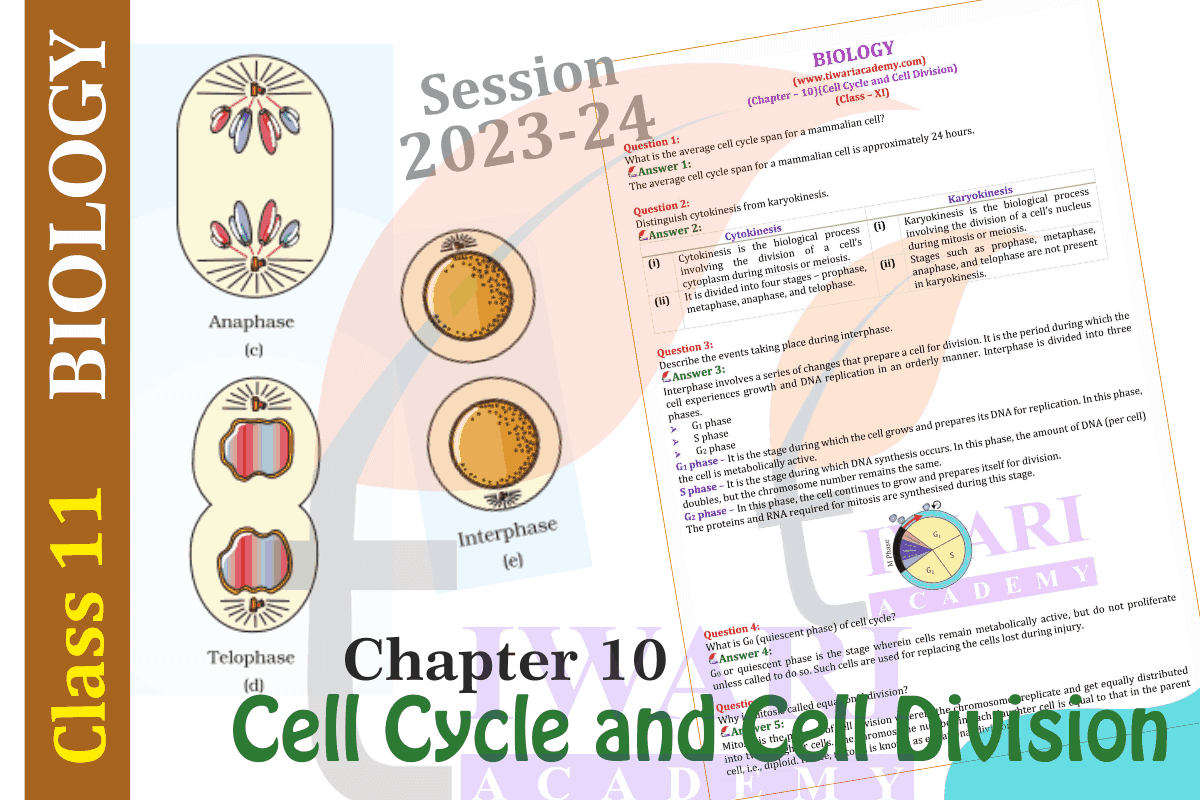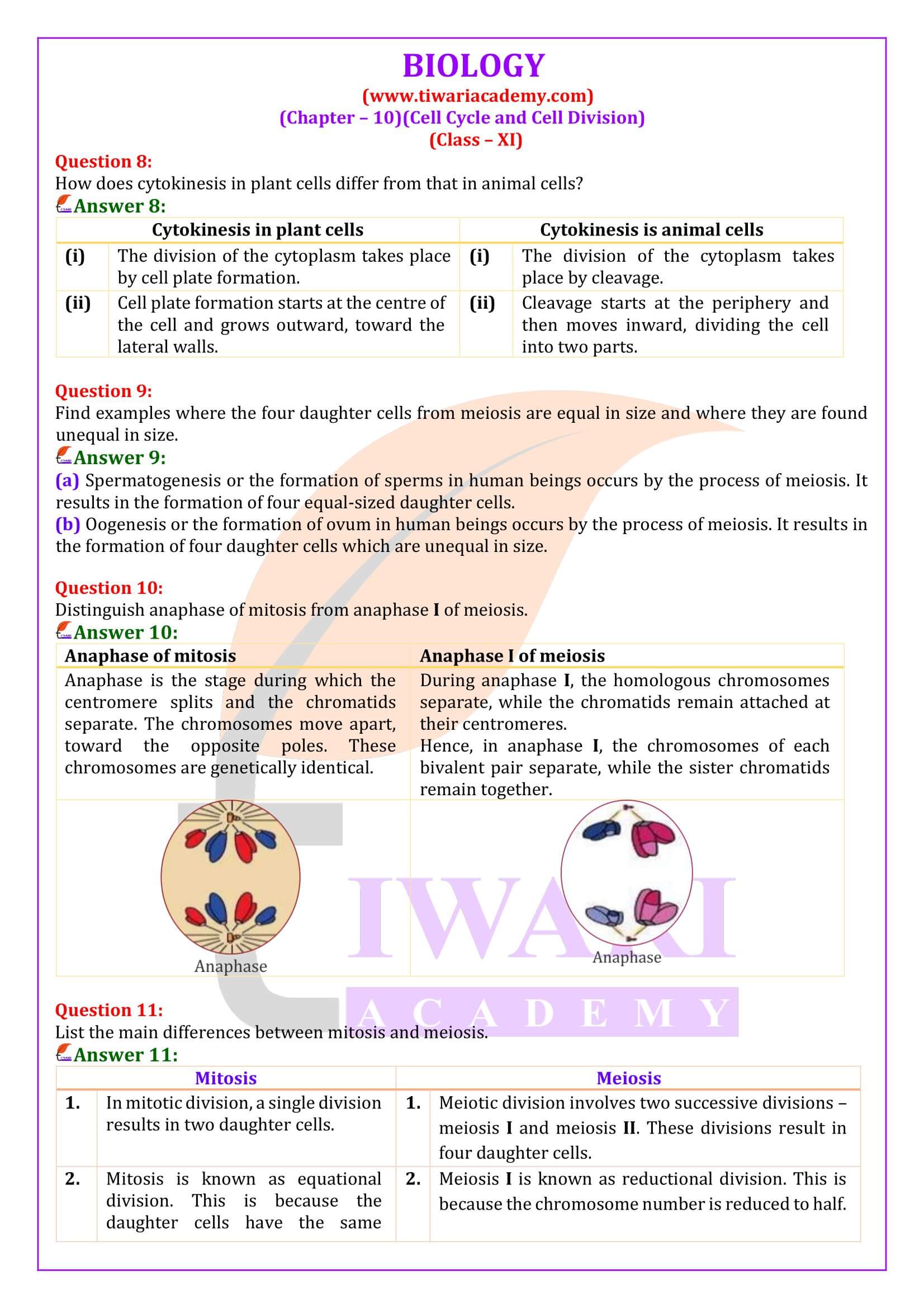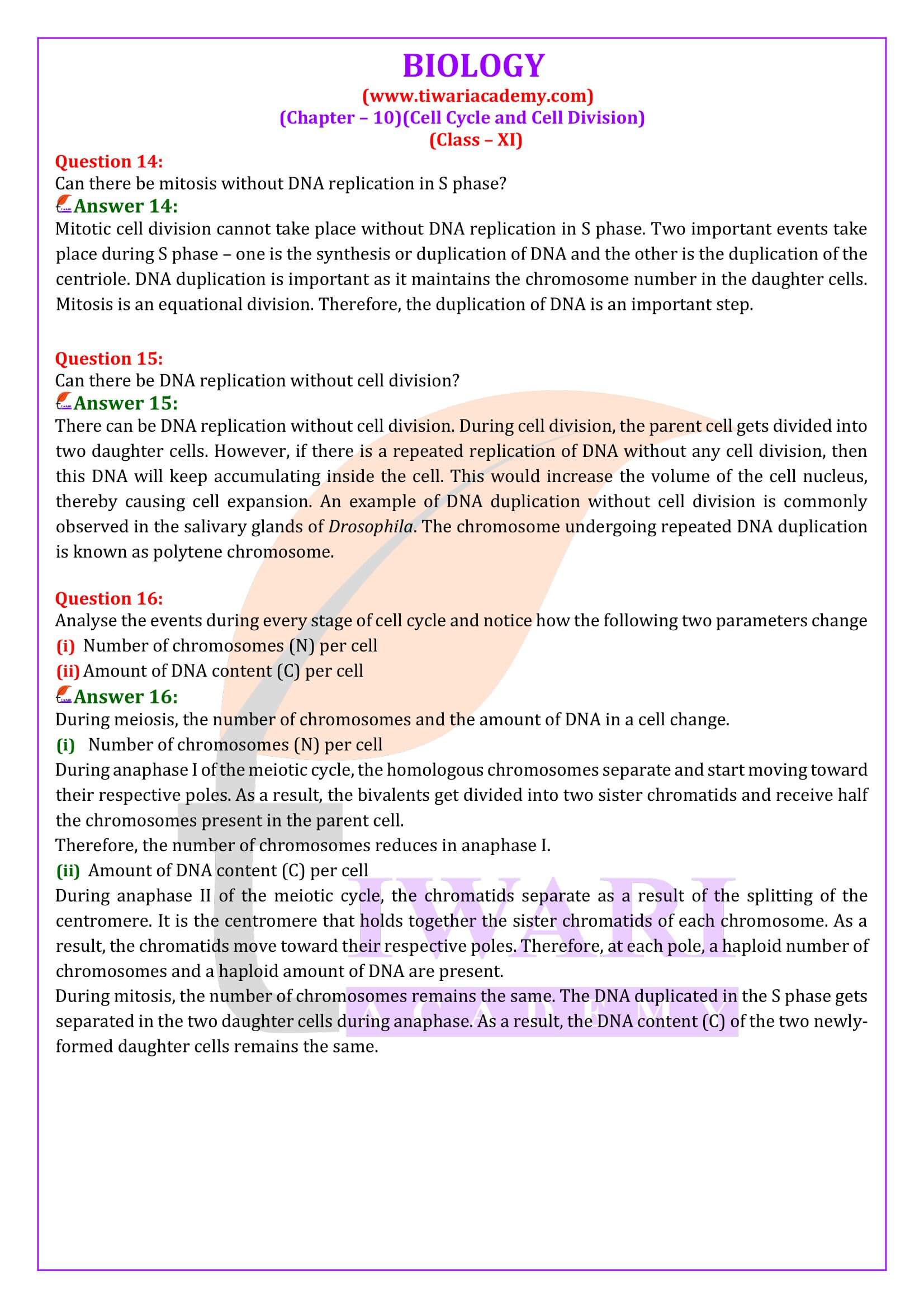NCERT Solutions for Class 11 Biology Chapter 10 Cell Cycle and Cell Division in Hindi and English Medium download in PDF files for or to Study online without downloading files updated for new academic session 2025-26. Download CBSE Offline Apps based on NCERT Solutions of other subjects and study notes related to all chapters. Ask your queries in Discussion Forum to share your knowledge with the others.
NCERT Solutions for Class 11 Biology Chapter 10
Class 11 Bio Chapter 10 Cell Cycle and Cell Division Solutions

| Class: 11 | Biology |
| Chapter 10: | Cell Cycle and Cell Division |
| Content: | Study Material and Exercises Solutions |
| Mode of Content: | Images, PDF, Text and Videos |
| Session: | Year 2025-26 |
| Boards: | CBSE and State Boards |
| Medium: | Hindi and English |
Class 11 Biology Chapter 10 Solutions in English
NCERT Solutions for Class 11 Biology Chapter 10 in PDF format to download free for new academic session 2025-26 based on latest NCERT Books 2025-26. Offline Apps are also updated for new session following the latest CBSE Syllabus 2025-26. Join the Discussion Forum to ask your doubts and discuss your educational problems. NIOS board provides you directly class 12 (after passing 10th) without doing 11th.

Important Notes on Cell Cycle and Cell Division
MEIOSIS
Specialised kind of cell division that reduces the chromosomes number by half, hence it is called reductional division.
Occurs during gametogenesis in plants and animals.
Involves two sequential cycles of nuclear and cell division called Meiosis I and Meiosis II.
It results in 4 haploid daughter cells.
Interphase occurs prior to meiosis which is similar to interphase of mitosis except the S phase is prolonged.
SIGNIFICANCE OF MEIOSIS
Format ion of gametes: In sexually reproducing organisms.
Genetic variability: Variations are very important for evolution.
Maintenance of chromosomal number: By reducing the chromosome number in gametes. Chromosomal number is restored by fertilisation of gametes.
Mitosis
Since the number of chromosomes in the parent and progeny cells is the same, it is called as equational division. Mitosis is divided into four sub stages.
1. Prophase
Replicated chromosomes, each consisting of 2 chromatids, condense and become visible.
Microtubules are assembled into mitotic spindle.
Nucleolus and nuclear envelope disappear.
Centriole moves to opposite poles.
2. Metaphase
Spindle fibres attached to kinetochores (small disc-shaped structures at the surface of centromere) of chromosomes.
Chromosomes line up at the equator of the spindle to form metaphase plate.
3. Anaphase
Centromeres split and chromatids separate.
Chromatids move to opposite poles due to shortening of spindal fibres.
4. Telophase
Chromosomes cluster at opposite poles.
Nuclear envelope assembles around chromosomes clusters’.
Nucleolus, Golgi Complex, E.R. reforms.
Important Questions on 11th Biology Chapter 10
What is the average cell cycle span for a mammalian cell?
The average cell cycle span for a mammalian cell is approximately 24 hours.
Describe the events taking place during interphase.
Interphase involves a series of changes that prepare a cell for division. It is the period during which the cell experiences growth and DNA replication in an orderly manner. Interphase is divided into three phases. G1 phase: It is the stage during which the cell grows and prepares its DNA for replication. In this phase, the cell is metabolically active. S phase: It is the stage during which DNA synthesis occurs. In this phase, the amount of DNA (per cell) doubles, but the chromosome number remains the same. G2 phase: In this phase, the cell continues to grow and prepares itself for division. The proteins and RNA required for mitosis are synthesised during this stage.
What is G0 (quiescent phase) of cell cycle?
G0 or quiescent phase is the stage wherein cells remain metabolically active, but do not proliferate unless called to do so. Such cells are used for replacing the cells lost during injury.
Why is mitosis called equational division?
Mitosis is the process of cell division wherein the chromosomes replicate and get equally distributed into two daughter cells. The chromosome number in each daughter cell is equal to that in the parent cell, i.e., diploid. Hence, mitosis is known as equational division.
Find examples where the four daughter cells from meiosis are equal in size and where they are found unequal in size.
(a) Spermatogenesis or the formation of sperms in human beings occurs by the process of meiosis. It results in the formation of four equal-sized daughter cells. (b) Oogenesis or the formation of ovum in human beings occurs by the process of meiosis. It results in the formation of four daughter cells which are unequal in size.
What is the significance of meiosis?
Meiosis is the process involving the reduction in the amount of genetic material. It comprises two successive nuclear and cell divisions, with a single cycle of DNA replication. As a result, at the end of meiosis II, four haploid cells are formed. Significance of meiosis Meiosis maintains the chromosome number from generation to generation. It reduces the chromosome number to half so that the process of fertilisation restores the original number in the zygote. Variations are caused by the cross-over and the random distribution of homologous chromosomes between daughter cells. Variations play an important role in evolution. Chromosomal mutations are brought about by the introduction of certain abnormalities. These chromosomal mutations may be advantageous for an individual.
Discuss with your teacher about (i) haploid insects and lower plants where cell-division occurs, and (ii) some haploid cells in higher plants where cell-division does not occur.
(i) In some insects and lower plants, fertilization is immediately followed by zygotic meiosis, which leads to the production of haploid organisms. This type of life cycle is known as haplontic life cycle. (ii) The phenomenon of polyploidy can be observed in some haploid cells in higher plants in which cell division does not occur. Polyploidy is a state in which cells contain multiple pairs of chromosomes than the basic set. Polyploidy can be artificially induced in plants by applying colichine to cell culture.
Can there be mitosis without DNA replication in S phase?
Mitotic cell division cannot take place without DNA replication in S phase. Two important events take place during S phase – one is the synthesis or duplication of DNA and the other is the duplication of the centriole. DNA duplication is important as it maintains the chromosome number in the daughter cells. Mitosis is an equational division. Therefore, the duplication of DNA is an important step.
Can there be DNA replication without cell division?
There can be DNA replication without cell division. During cell division, the parent cell gets divided into two daughter cells. However, if there is a repeated replication of DNA without any cell division, then this DNA will keep accumulating inside the cell. This would increase the volume of the cell nucleus, thereby causing cell expansion. An example of DNA duplication without cell division is commonly observed in the salivary glands of Drosophila. The chromosome undergoing repeated DNA duplication is known as polytene chromosome.
Significance of Mitosis
Growth-addition of cells.
Maintenance of surface/volume ratio. Maintain Nucleo-cytoplasmic ratio.
Maintenance of chromosomes number.
Regeneration.
Reproduction in unicellular organisms, lower plants and some insects.
Repair and wound healing.
Vegetative reproduction in plants takes place by mitosis.








